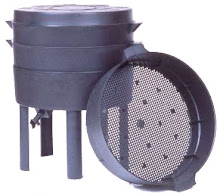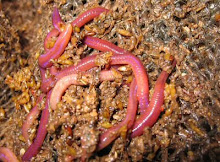"The Adventures of Herman: The Autobiography of Squirmin' Herman the Worm", a kid-friendly, educational, and cute website, comes courtesy of the University of Illinois at Urbana-Champaign Extension Urban Programs Research Network. The site offers a brief history of vermicomposting in America, offers instructions on creating and maintaining a worm bin, and reviews essential information on worm anatomy, feeding, and reproduction, as well as an overview of worm bin environs.
Some wild facts about worms: First: they're hermaphroditic! Mature worms have both male and female reproductive parts located in their clitellum, a light-colored, swollen, ring. When worms mate, they join, with their heads pointing in opposite directions. They exchange sperm, which is stored in sacs, and cocoons form on the clitellum of each worm. As the worms back out of the cocoons, they deposit sperm and eggs into the cocoons. Once the cocoons close, fertilization takes place. Cocoons can be produced on the order of once a week. Each cocoon holds 1-5 worms and can lie dormant until ideal (read: moist) conditions emerge: they take 2-3 weeks to hatch.
Worms have five hearts, and since they have no lungs, oxygen diffuses across their moist skin, moving from the area of higher concentration (the air) to the area of lower concentration (inside the worm). This is why it's essential not to feed the worms oily food, as it interferes in absorption.
Worms have small mouths, located in the first anterior segment, hence can only feed on small things: bacteria, fungi, protozoa, and organic material. A flap, located near the mouth, called the prostomium helps keep unwanted particles out. Since they have no teeth to break down their food, an organ called a gizzard does the work. Some worm sites suggest adding garden lime, eggshells, or sand to aid the worm in grinding down the food. When the gizzard contracts, the small grains and grit inside of it compress against the food, grinding it into digestible particles that subsequently enter the intestine. There, digestive enzymes break down the nutrients, which pass through the intestinal wall and are absorbed in the bloodstream. Undigested waste material passes through the anus as vermicast.
To some extent, worms can regenerate: if their posterior (tail) end is severed, they can grow a new tail, but the same cannot be said if their anterior (head) is lopped off.


